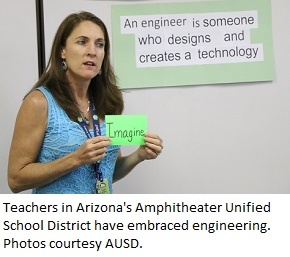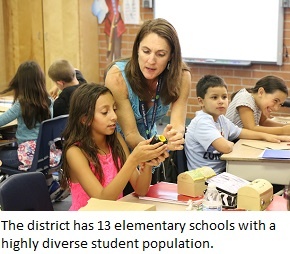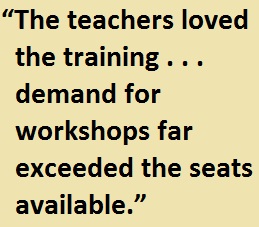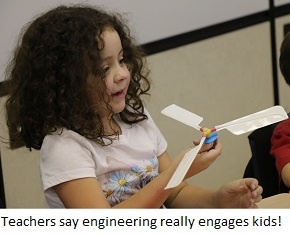 This blog was originally posted on January 7, 2016.
This blog was originally posted on January 7, 2016.
We’re always interested to learn how districts adopt and implement the EiE curriculum. One challenge many districts face is simply finding the funds for curriculum materials, another is building consensus and enthusiasm among teachers.
Amphitheater Unified School District in Tucson is a great example of a district that’s seeing a highly successful EiE implementation despite serious budget constraints.
Diverse Schools, Diverse Students
 Amphi is Tucson’s third largest public school district, and it’s notably diverse. Covering a 110-square-mile region, it includes inner city, suburban, and rural schools. The student population is socioeconomically and culturally diverse; at some schools, almost all students receive free and reduced lunch, at others, almost none do; close to 50 percent of students in the district are Hispanic; and a significant number of students are refugees from war-torn nations in Africa.
Amphi is Tucson’s third largest public school district, and it’s notably diverse. Covering a 110-square-mile region, it includes inner city, suburban, and rural schools. The student population is socioeconomically and culturally diverse; at some schools, almost all students receive free and reduced lunch, at others, almost none do; close to 50 percent of students in the district are Hispanic; and a significant number of students are refugees from war-torn nations in Africa.
The district’s 13 elementary schools are even diverse in the way they are structured! Ten are traditional elementary schools serving grades K–5; one is a K–6 school; and two are in K–8 facilities. Altogether, Amphi has about 7,000 elementary students.
Pilot Project Exceeds Expectations
In 2014, Amphi made a commitment to re-energize STEM education in its elementary schools. Over the course of a year, educators developed science guides mapped to state standards, and included design thinking as an element in these guides.
But initially, integrating engineering with elementary instruction wasn’t an express goal; instead, Dr. Roseanne Lopez, chief academic officer for elementary education, was tasked with launching engineering instruction for middle school students.
“Then, while researching an appropriate middle school curriculum, I found EiE,” she says. “When I started exploring the website, I got really, really interested! I was very impressed by what it offered students. I decided that, once the middle school curriculum was up and running, I would see if our elementary schools were interested in moving in this direction.”
 In the summer of 2015, Lopez arranged for the Arizona Science Center, one of EiE’s professional development collaborators, to offer two EiE teacher workshops: one for educators in grades K– 2, one for grades 3–5. She saw the event as a pilot project . . . but then she got an unexpectedly positive response from teachers. “It was really gratifying—we invited all thirteen schools to the workshops, and teachers from all thirteen schools showed up,” she says. “Not only that, but demand for the training far exceeded the seats available, so we offered two more sessions.”
In the summer of 2015, Lopez arranged for the Arizona Science Center, one of EiE’s professional development collaborators, to offer two EiE teacher workshops: one for educators in grades K– 2, one for grades 3–5. She saw the event as a pilot project . . . but then she got an unexpectedly positive response from teachers. “It was really gratifying—we invited all thirteen schools to the workshops, and teachers from all thirteen schools showed up,” she says. “Not only that, but demand for the training far exceeded the seats available, so we offered two more sessions.”
By the end of 2015, more than 100 of the district’s nearly 350 elementary teachers were prepared to teach with EiE. Lopez was also able to send three particularly enthusiastic teachers to an EiE Teacher Educator Institute—a train-the-trainer workshop that qualified them to facilitate EiE workshops for still more Amphi teachers.
A Flexible Approach to Funding
The district provided each teacher who attended a workshop with an EiE teacher guide. “The teachers loved the training so much,” Lopez says, “they said, ‘We want the kits too! This will be really good for our kids.’”
But they couldn’t afford the EiE materials kits. During the Great Recession, Arizona cut state funding for schools drastically—more than any other state. Between 2008 and 2014, per-student funding declined more than 23 percent.
Seeing how engaging EiE was for students, and seeing the positive feedback from teachers, the individual schools found ways to make it all happen. “We had to get creative,” Lopez says. “Schools found money to purchase kits every way you can think of.”
Some PTAs held fundraisers. “At Harelson Elementary, the PTO committed to supporting EiE implementation within a couple weeks after the school year started,” Lopez says. “They bought every single EiE kit, and also set up a space in the school as a dedicated science lab/makerspace/engineering lab! The teachers really appreciate having a space set aside for engineering activities where they can spread materials out and not worry about making a mess.”
Other schools approached private donors. Still others looked hard at their budgets and somehow found funding.
Raytheon Engineer to the Rescue!
Meanwhile, a retired Raytheon engineer who lives in the district heard about the EiE implementation and contacted Lopez to offer more help. Rosemary Badian had previously coordinated programs to bring Raytheon volunteers into Tucson-area districts where the company supported EiE implementation through the Raytheon–EiE scholarship program, a component of a $2 million, five-year initiative to jumpstart the use of EiE in high-needs schools and districts.
“Rosemary said, ‘I want to come help you, too . . . and I have a whole bunch of friends!” Lopez says. “She knew everything about every EiE kit, what was in them and what had to be done, and she just threw herself into it.”
Badian organized a group of volunteers to come to Amphi’s Keeling Elementary, an inner-city, high-poverty school, for “STEM Thursdays.” Each week this past fall, five to ten volunteers have turned out to prep the materials needed for the day’s EiE lesson—for example, assembling milk-carton windmills for the Catching the Wind unit. The volunteers also assist in the classroom.
Implementation Exceeds Expectations
 Lopez says that she started exploring EiE with a modest goal: Giving schools some options in science instruction. “Sometimes rolling out a new curriculum takes time, but this took off quickly!” she says. "It turned out to be a much bigger implementation than I expected. We just held the workshops this past summer, and already nine of our thirteen elementary schools have either integrated EiE into classroom instruction or will be doing so pretty soon.”
Lopez says that she started exploring EiE with a modest goal: Giving schools some options in science instruction. “Sometimes rolling out a new curriculum takes time, but this took off quickly!” she says. "It turned out to be a much bigger implementation than I expected. We just held the workshops this past summer, and already nine of our thirteen elementary schools have either integrated EiE into classroom instruction or will be doing so pretty soon.”
One school that has adopted EiE in a big way, Walker Elementary, was named Southern Arizona STEM School of the Year at the 2015 Southern Arizona Research, Science and Engineering Foundation (SARSEF) Fair. One award-winning student is fifth grader Kaylynn Calvin, who designed and built a glove that protects your fingers from needle sticks while sewing. EiE designs each engineering activity to connect with student’s real world experiences, so we were impressed to learn that Kaylynn connected her engineering work to her family’s Navajo crafting traditions. She’ll go on to compete at the state level.
It’s too soon to say whether science test scores are improving in the district, but Lopez says, that’s not the point. “One of our underlying goals is increased student engagement, and teachers tell me students seem to be doing deeper thinking and really showing off their problem solving skills. The engagement they see while doing the EiE lessons is higher than almost anything else in the school day.”
We designed EiE with this express goal in mind . . . but it’s feedback we always love to hear.








